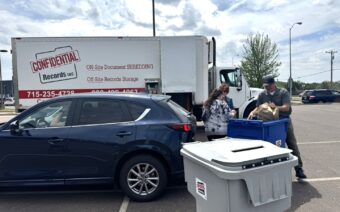
March 4, 2024
CENTRAL WISCONSIN – It was none other than Wisconsin’s Vince Lombardi who said, “Individual commitment to a group effort – that is what makes a team work, a company work, a society work and a civilization.”
President and CEO Angel Laidlaw said Centergy, a regional marketing and economic development nonprofit, works off of a similar ethic, as it “envisions itself as the collective voice for advancing prosperity and vibrancy in the region.”
Laidlaw said the organization, along with its investors and other groups – such as Gamber Johnson, Main Street Marshfield, Miron, Greenfire and Crystal Finishing – work together to make an even better Central Wisconsin.
Centergy’s annual Central Wisconsin Days, she said, is a prime example of coming together as a collective group to advocate for the region.
Since 2005, Laidlaw said Central Wisconsin organizations and businesses have come together at the capitol in Madison to discuss current issues at hand within the region’s landscape, as well as potential solutions.
“Central Wisconsin Days is incredibly important to our region because it provides a platform for our communities, businesses, organizations and individuals to have their voices heard,” she said. “If we don’t actively communicate what’s happening in our communities and how our businesses are being impacted or struggling, who else will?”
The 19th Central Wisconsin Day’s- – held last month – focused on workforce challenges, which Laidlaw said were addressed in three different subsets:
- Childcare
- Business tax credits
- Rural bridges
Laidlaw said representatives from Gamber Johnson, Main Street Marshfield, Miron, Greenfire and Crystal Finishing were at the capitol to advocate solutions for the workforce challenges with lawmakers.
Childcare
Laidlaw said childcare has become a recurring topic of conversation throughout the state in recent years – more specifically, the lack of childcare options.
According to a survey done by Childcaring – a childcare agency in Mosinee – 81% of childcare programs have a wait list, 31 classrooms have closed and 333 staff members have been lost in 12 months.
And that’s just in Central Wisconsin.
Throughout the entire state, the Wisconsin Economic Development Institute said the long-term economic impact of the childcare crisis is estimated from $4.2 billion to $6.4 billion.
The childcare dilemma, Gautam Malik, CEO of Gamber Johnson, said is happening for a variety of reasons.
“All the daycare centers – the wages are not attractive enough to employ new workers,” he said. “Some of these centers are at capacity. And, you’re not going to have a baby and say, ‘you know what, I’m going to (wait) to have a baby because the (waitlist) is two-and-a-half years.’ That’s not a practical way of going around childcare.”
The cost of childcare also poses a roadblock for some parents, which he said is why Gamber Johnson tries to alleviate those concerns for its employees.
“We will put $5,000 toward childcare,” he said. “Now, $5,000 isn’t going to go (a) long (way), but again, it’s going to help ease the pain when it comes to paying for expensive childcare.”
With fewer options and accessibility for childcare, more parents are choosing to stay home with their children, which Kaelie Gomez – executive director at Main Street Marshfield – said can be “detrimental to the workforce.”
“I know many well-educated people who are home with their kids, and it was a conscious choice, but they would be an incredible asset to Central Wisconsin should they be in the workforce pulling us forward,” Gomez, who attended this year’s Central Wisconsin Days, said.
Craig Uhlenbrauck, senior vice president of Miron’s Wausau office, said the construction company is looking for solutions to the childcare crisis within its organization as well, as many of its employees are younger.
“I know in my office here in Wausau, there are a lot of younger families having kids,” he said. “(We’re) seeing the struggles they’re going through to try and find childcare facilities and continue to balance work from their personal life. That’s probably the biggest (problem) from Miron’s perspective.”
Maureen Carlson, regional business development manager at Greenfire, said to help address the crisis, there needs to be a public-private partnership.
“The State of Wisconsin and private businesses (need) to come together to come up with a solution,” she said.
Malik said the Assembly Bill 660 Centergy that partners and investors advocated for at this year’s Central Wisconsin Days would do just that.
“What can we do from a business tax credit standpoint to support those companies (that are investing in childcare)?” he said.
The credit, according to the Wisconsin State Legislature, “is equal to the amount of capital expenditures incurred in establishing an employee childcare program, the amount of certain organization and administration expenses incurred and the amount of contributions made to a charitable organization to establish an employee childcare program.”
Business tax credits
Centergy and the above organizations also brought business tax credits to the table at Central Wisconsin Days.
Though the Wisconsin Economic Development Corporation (WEDC) has provided tax credits to businesses for more than 10 years, Malik said the business tax credit (BTC) doesn’t help Wisconsin employers who are seeing a workforce shortage.
And, since the COVID-19 pandemic and the baby boomer generation heading toward retirement, he said it is a problem for a large number of businesses throughout the state.
“Having a premise that you’re going to go find people is going to be tough,” he said. “We’ve got a lot of baby boomers, five to seven every year, who are retiring, and human resources is going to have a tough time selling those positions.”
Gomez said businesses ineligible for the BTC because they’re not bringing in more employees – but would benefit from expansion efforts or infrastructure, in turn boosting the economic development of its community – are unable to do so because they can’t get the credit.
“There are a few businesses here (in Marshfield that) we would love to see expand and have that opportunity to grow,” she said.
To solve this issue, Carlson said the BTC needs to be updated to address worker shortage.
“The tax credit needs to be based on capital expenditures and job retention,” she said. “Ten years ago, there wasn’t the worker shortage there is today. It’s not working as it should in the State of Wisconsin, and that’s why this bill is so important.”
Christina Lammerding, talent acquisition and retention manager at Crystal Finishing, said the BTC reform bill has the opportunity to impact organizations not only in Central Wisconsin but throughout Wisconsin.
“We’re seeing the population of our workforce decline heavily in Wisconsin in comparison to other states,” she said. “So, being able to say, ‘can we use that same credit from a capital expenditure and gains aspect and show that investment is going back in?’ would allow us to continue moving forward and feel like we have that support, and also be able to attract other businesses.”
The introduced changes to the BTC program (within Assembly Bill 627) include:
- Increasing the maximum claimable amount for capital expenditures from 3% (personal property) and 5% (real property) to 10% for both
- Introducing additional tax benefits equivalent to 15% of the amount invested by a BTC-eligible business in workforce housing and childcare programs for its employees
- Mandating WEDC to approve or deny BTC applications within 90 days
Rural bridges
Rural bridges were also a topic addressed during Central Wisconsin Days.
“Many of the bridges have not been updated in more than four years, so it’s a safety concern,” Carlson said. “It affects rural Wisconsin, where Central Wisconsin has a lot of rural areas.”
The average age of rural bridges in Central Wisconsin, Malik said, is 41 years old, which means “a lot of TLC is required.”
Under the current law, the Wisconsin State Legislature said the Department of Transportation (DOT) conducts a local bridge program in order to determine which bridges need to be reconstructed and rehabilitated.
Through the program, DOT allocates funds to counties “based on the ratio between the estimated cost of reconstructing or rehabilitating qualifying bridges in that county and the estimated cost of reconstructing or rehabilitating qualifying bridges in the state.”
The law, Malik said, “has been working great.”
“You’ve got the (Federal Reserve System) helping with 80% of the money,” he said. “You’ve got the township that comes up with 10% of the money, and then the county comes up with another 10%. There is a mechanism to share those costs.”
If the local bridge program has been working great for nearly five decades, some may be asking, ‘what’s the issue?’
“An attorney general highlighted that this method of cost-sharing is not statutorily allowed,” Malik said.
Assembly Bill 808 (Senate Bill 753), he said, aims to make it legal, in that “county bridge aid may be used to fund the local share of a local bridge program and that, if county bridge aid is used for this purpose, (then the) DOT (would) supervise the project.”
“What we are asking (for) is something that has worked – make it legal – so the sharing continues,” he said. “We’ve got employees who live out in the country, and their commute is going to go from 30 minutes to 60 minutes if one of those bridges fails.”
The bridges, Malik said, are also crucial for access to recreational activities for Central Wisconsin residents.
“We have great outdoors in the Central Wisconsin region, why not keep that?” he said. “People enjoy hunting, people enjoy fishing and those bridges are huge. We have more than 10,000 lakes in Wisconsin, so why not use and enjoy those? That’s where the rural bridges come into the picture.”
The power of coming together
To have organizations and businesses come together as a collective group from all different sectors of the workforce and advocate for solutions to these issues throughout Central Wisconsin, Uhlenbrauck said, is what it’s all about.
“We’re all dealing with these challenges,” he said. “It’s not just Miron in the construction industry. There are manufacturing challenges. The healthcare industry has its challenges. The technical colleges have their challenges. Everybody’s dealing with a lot of the same thing. We appreciate that we can all be together and have a unified voice in these discussions.”
Lammerding said one voice is one voice, “but when you have a collaborative, and you have many voices, it’s easier to hear them.”
“We may walk in different industries, but we are in this together, and our success is codependent on each other,” she said.
Working together to accomplish these bills being passed, Malik said, can be credited back to Aristotle’s ethics.
“The whole is greater than the sum of (its) parts,” he said. “We have to take the high road on becoming better as a community to be able to attract new talent in the Central Wisconsin region.”
Bringing these issues directly to the capitol, Uhlenbrauck said, is also impactful.
“I think it’s important that (representatives/senators) hear from people and hear real-life stories because a lot of times on the legislative side, a lot of it is facts and figures and statistics,” he said. “So, when they get to hear from people who are living and breathing these experiences and these challenges in the communities we live in, I think it means a lot to them.”
More about Centergy and Central Wisconsin Days can be found at centraltosuccess.com.
 Jeopardy! champ pays it forward
Jeopardy! champ pays it forward Solar plant shines light on process, benefits
Solar plant shines light on process, benefits








